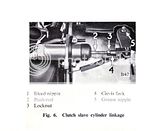Lukens
Jedi Warrior
Offline
Getting aggravated.
Should not the return spring on the slave pull the plunger all the way to it's fully retracted position?
When I adjust the slave pushrod with a little clearance and work the clutch, the clearance is disappears. Run the rod in the clevis to achieve more clearance, work the clutch, and that clearance is gone. I can keep doing this until all the adjustment on the rod is gone, and the plunger just creeps further and further away from fully retracted. However, I can force the plunger home with my hand.
I'm considering a longer, stiffer, spring. (Aren't we all? lol)
Russ
Should not the return spring on the slave pull the plunger all the way to it's fully retracted position?
When I adjust the slave pushrod with a little clearance and work the clutch, the clearance is disappears. Run the rod in the clevis to achieve more clearance, work the clutch, and that clearance is gone. I can keep doing this until all the adjustment on the rod is gone, and the plunger just creeps further and further away from fully retracted. However, I can force the plunger home with my hand.
I'm considering a longer, stiffer, spring. (Aren't we all? lol)
Russ

 Hi Guest!
Hi Guest!

 smilie in place of the real @
smilie in place of the real @
 Pretty Please - add it to our Events forum(s) and add to the calendar! >>
Pretty Please - add it to our Events forum(s) and add to the calendar! >> 
